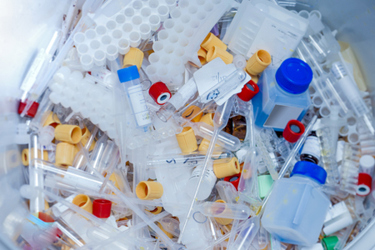Scale And Sustainability In Single-Use Systems

By Matthew Pillar, Editor, Bioprocess Online

Mark Petrich, Ph.D., is a chemical engineer. Over the course of 18 and a half years spent working at Merck, first in pilot plant management during the late 1990s, and later in process engineering and directorial roles overseeing vaccine, sterile, and pharmaceutical manufacturing, he played a hand in designing processes that utilized some of the biggest, shiniest, and most beautifully-engineered biopharmaceutical manufacturing equipment in the world.
Mark Petrich, Ph.D. is also a pragmatist. Over the course of those nearly two decades at Merck, his affinity for stainless steel at grand scales gave way to the practicalities, efficiencies, and flexibilities afforded by plastic. By the time he wrapped up his time there, Petrich was Director of Single-Use Engineering at Merck, responsible for the strategy, procurement, deployment, and execution of 800+ distinct single-use bioprocessing SKUs in several million square feet of lab and manufacturing space, spread across multiple continents.

Much of my most recent conversation with Petrich, who’s now VP of process development and validation at Krystal Biotech, was focused on single-use scale and lifecycle management. Here are some of his pearls of wisdom.
Single-Use Versus Traditional: Scale Considerations
Petrich, who’s a recipient of the Bioprocess International Industry Champion Award for promoting collaborative efforts in design, qualification and application of single use technologies and biopharma manufacturing, understands the nuance in single-use decision making better than most. There’s the obvious: newer, early clinical-stage programs can get batches off the ground much faster, and with far less expense, by leveraging single-use technologies. But in this biotech startup environment, where “outsource everything” is the mantra, there are even longer-term benefits, tech transfer being chief among them. “If you go to a CMO, it's unlikely that they're going to have exactly the equipment that you're going to need,” says Petrich. “Going with the single use option, you can design, source, and select quicker, and you can also make changes as you go. That’s tougher—not impossible—but tougher with stainless steel.”
As volume goes, it would seem obvious that a manufacturer running multiple 15,000-liter bioreactors to produce millions of doses of flu vaccine perennially would justify the expense of traditional stainless steel bioprocessing technology. It would seem equally obvious that a manufacturer of patient-specific autologous cell therapies with a lead clinical candidate in rare disease would opt for single-use, and we’ll touch on that a bit later. But as biopharmaceutical manufacturing scale goes, the majority falls somewhere in the middle, which requires an economic assessment for those falling within that middle somewhere. There is a tipping point, and Petrich points to a host of resources from ISPE (International Society of Pharmaceutical Engineers), BSPA, and independent papers, like this one authored by his colleague Jeff Johnson, that offer economic guidance on single-use decision-making.
Where Hybrid Fixed/Single Use Makes Sense
Drawing from both his process engineer and pragmatic attributes, Petrich reminds us that the first and most important considerations in the traditional versus single-use assessment are product and process requirements. “Don’t begin the assessment with what material you want to buy for your equipment. Begin with what you’re trying to do,” he says. “As you define what you’re trying to do, single-use might provide alternatives to what has historically been used. There are numbers of success stories, COVID vaccines being a large one, where single-use enabled very rapid deployment of a new product. Sometimes your priority is time. Sometimes it’s cost. Sometimes it’s a very specific performance attribute requirement.” He points to centrifugation and chromatography as notable examples. “Many times, people they’re not going near single-use centrifugation or chromatography because in their opinion, and for the products they're working with, they just can't get the performance they need. Other people don't need that same performance, and for them, single-use is an obvious choice.”
It's a combination of this continuous assessment of requirements and advances in single-use technologies that have driven hybridity in most biopharmaceutical manufacturing environments. “Most of the hybrid systems that I've seen started out as full stainless-steel systems,” says Petrich. As those systems were being upgraded, as production scale changed, or as certain components reached end of life, we began to see hybrid take hold. “We started to see large stainless tanks with single-use jumper pieces between them, for instance,” he says. If you have an elaborate mixing system, for instance, where high shear is required and you're trying to get some emulsion to occur, Petrich says he wouldn't advocate for a switch over to single-use mixers if the equipment you’re already running meets the requirement. “Though single-use mixer technology is quite nice, you'd have to redevelop your process, and you'd have the regulatory filings we deal with in our industry any time we make a change,” he says.
When Single-Use Process Change Pays Back
On the other hand, Petrich offers a great example of an intentional move toward hybridity contributing to higher efficiency. “If you have a multi-vessel stainless steel system with piping, interconnecting, and lots of automated valves, where basically the whole building is the factory and everything's connected, it’s very difficult to partition that for steam-in-place and clean-in-place validation,” he says. In that scenario, a problem in one unit often slows the process down in another area, and those problems are often revealed at the time of facility qualification or startup. “By breaking this up into single vessels and single pumps transitioned by single-use technologies, you decouple the system,” he says. “That simplifies the job of the validation engineer, startups usually go quicker, and maintenance is easier.”
Single-Use For Personalized Therapeutics
Petrich admits that in the decade since single-use technologies have gone mainstream, the industry has gotten a bit sloppy with the nomenclature. “Usually, when you talk about a single-use system, you’re also talking about a closed system,” he says. Where the terms closed system, sterile system, and ready-to-use system were once used in a literal sense, but without a “fixed” or “single-use” qualifier, those in the single-use industry have come to use them almost synonymously with single-use systems. “Closed system, truly sterile connections are a very important part of the cell therapy industry, whether it be tube welding or some of the fancy new aseptic connectors,” says Petrich. “Those connections are what put you in a position to operate in a lower-level clean room environment than you would have to with open aseptic connections.” In autologous cell therapy manufacturing, where the entire process addresses one patient at a time on a small equipment scale with small volumes of material, Petrich says a number of single-use aseptic technologies, including connectors and tube welding, are effective at closing those systems. Again, he says the driving factors aren’t the materials, but the requirements of autologous cell therapy production.
The Single-Use Sustainability Paradox
How could anyone advocate for the use of more plastic in manufacturing processes in the name of sustainability, and do so with a straight face? Petrich does, and he embraces the paradox. “Using plastic in our industry is a good thing for the environment,” he says.
In short, single-use technologies—plastic and disposable as they may be—enable such a profound reduction in the water, energy, physical footprint, and chemical cleaning agents required of traditional, fixed systems, they contribute to a reduction in the manufacturer’s carbon footprint. It’s not just theory. Petrich and his colleagues have measured it, sourced other independent measurements, and documented their findings in a multi-part series of papers titled The Green Imperative, available at bpsa.org.
Petrich is proud of the work he and his colleagues have done on the sustainability front, and he implores everyone in the industry to analyze the impact of their manufacturing systems, but that’s not to say that he’s satisfied with the current single-use sustainability paradigm. “You’ve still got to throw something away, and that feels bad,” he acknowledges. As such, he’s advocating for responsible disposal and, potential recycling, of spent single-use technology. But he also says it’s important to keep things in perspective. We’re not talking about the decommissioning of as much plastic as one might assume.
“When we talk to recycling companies, the first question they ask is, how much material do you have? When they hear how much plastic waste we’re producing from a single plant, they’re generally not all that interested,” relays Petrich. Recognizing that there’s power in a collective, biopharmaceutical equipment suppliers (Millipore-Sigma led the charge) and biopharmaceutical companies themselves have come together to create partnerships with other producers of plastic waste in the life sciences industries, primarily hospitals. Working together, larger volumes of plastic are being collected and consolidated for responsible disposal and, where possible, recycling.
One Industry’s Trash Is Another’s Treasure
In Pittsburgh, where Petrich’s Krystal Biotech is currently based, a nearby company called Triumvirate that collects plastic waste from Pittsburgh-area hospitals has now added major pharmaceutical manufacturers to its client roster. “Triumvirate is a licensed sterilizer and medical waste treatment facility, and they’re converting the waste they collect into plastic building materials,” says Petrich. “If you're a biotech with plastic that needs to be disposed of, you need to join with others to get the critical mass required for a recycling operation to be interested.”
Petrich and I, along with independent single-use systems expert and well-known advocate Paul Priebe, covered a lot more during our 60-plus-minute discussion on single use. We talked at length about sourcing, standards, and regulatory considerations, for instance, which was the focus of this recent writeup featuring Priebe’s insight. Watch the whole talk on demand here, and stay tuned for a recap of the BSA Summit later this summer.
